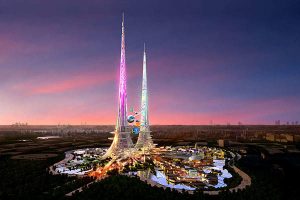New Approaches to Urban Planning

Perhaps even more exciting, is the technological advances that account for the possibility of sky-scraping cities, and floating cities around the globe.
Sky-scrapers in the future won’t only produce food. They will host entire cities of their own, built in vertical format.
In 2018, there were plans to build over 40 new sky scrapers that would be taller than 400 meters. Half of them will be constructed in China.
The best example of this may be the Phoenix Towers. These towers are expected to be twice as tall as the 830 meter Burk Khalifa, which in 2020 stands as the world’s tallest building.
The Phoenix Towers have been proposed for the city of Wuhan, China. These towers would stand at 1,000 meters, and would serve to clean local air and water pollution. The towers will be completely self-sustaining, made possible with the use of wind turbines, solar panels, and hydrogen fuel cells.
Another great example is the Jeddah Tower, a 1,000-meter-tall project that’s designed to function as an independent city. This massive construction in Saudi Arabia is expected to open its doors in 2020, and will cost over $1.3 billion dollars.
One last example could be the Sino-Singapore Tianjin Eco-city, a collaborative agreement between the governments of China and Singapore, to jointly develop a socially harmonious, environmentally friendly, and resource-conserving city, in China.
This sustainable community would be able to host 350,000 residents, and is expected to be completed by 2020. The development would feature solar and wind technologies as well as rainwater recycling, wastewater treatment, and seawater desalination systems. The beginning of construction work began in 2008 and the project continues to develop.
Previous Section:
Next Section:
Acknowledgments
Thank you for reading!
Please donate to help us publish this book.
PayPal: trevesbruno@gmail.com
Venmo: @Bruno-Treves



